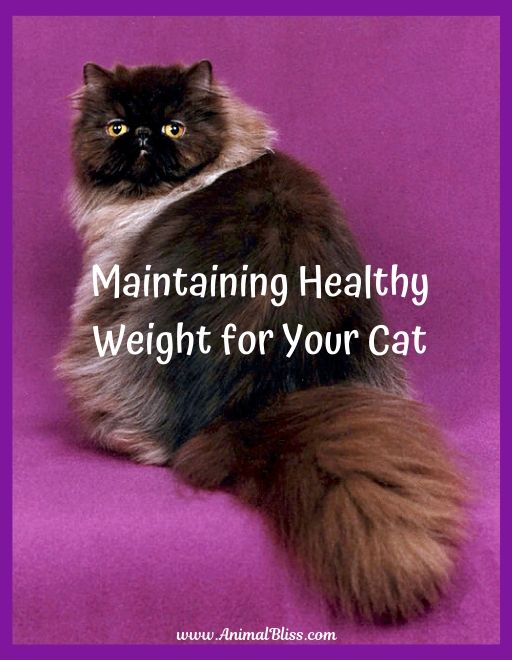Much like people, the definition of a healthy weight differs from cat to cat. While some breeds are obvious exceptions to the rule, most domestic adult cats fall between the 8-12 lbs range.
It’s always a good idea to get the advice of a professional veterinarian first if you have any concerns about your cat’s weight, but you can check for some obvious visual cues yourself.
The best way to do this is to pay attention to your cat’s body shape rather than the number on the scales. A healthy cat should have an hourglass-esque figure when looked at from above. You should be able to feel (but not see) their ribs and their belly shouldn’t sag.
Changes to a cat’s weight should be attempted gradually, and you should always consult your vet before making drastic changes to their diet.
With that said, here are some tips you can keep in mind if you need to sway their weight one way or the other.
Maintaining a Healthy Weight for Your Cat
1. Use a grain-free, high protein, low carbohydrate food
For most people, this can be as easy as switching from dry food to canned food, which tends to have higher levels of protein, since many dry food options require carbohydrates to bind the food together and form kibble.
If you do prefer dry cat food (plenty of owners do!) then look for crude protein content of around 35 percent or more. You should always favor animal-based proteins, as cats are poorly equipped to digest plant-based ones.
Dry foods with cold-formed kibble are a step in the right direction. Cold-formed kibble is the cat equivalent to not overcooking your vegetables, which causes their nutritional value to be lost.
Both types of food are viable providing the quality of ingredients and portion sizes are correct. That takes us nicely onto our next point.
2. Use appropriate portion sizes
Another benefit of moving to canned or pouched food is that it takes away the temptation to free-feed. This is especially important for owners who have overweight cats. Free-feeding means leaving a bowl of food around all day long for them to help themselves, and it’s a major contributor to the rise in feline obesity.
Controlling portion sizes also means introducing a feeding schedule. Portions should be based on two factors; the direction you want your cat’s weight to go in and the number of calories in the food you’ve chosen.
Not all foods are equal in calorific content. The caloric density of dry food can range anywhere from 300 kcals to 500 kcals and beyond. You should check the food manufacturer’s website to see the recommended portion sizes for cats of different sizes.
If you struggle to measure portions, or aren’t around enough to ensure consistent mealtimes, you should take a look at automatic food dispensers. Some of the top models can hold up to 24 meals at a time and can even be scheduled on your phone when you’re not at home.
Related:
Top 5 Reasons Why Your Cat Might Be Losing Weight
3. Make mealtimes fun
This is a surprisingly easy win for most cat owners and involves barely any time investment on your part.
Take a quick look at small, inexpensive products such as interactive feeders, you’ll be amazed how simple they are, but they have a positive effect on mealtime engagement.
Some feeders are simple rubber mats with shapes that make your kitty work for their treats by fishing them out. It can turn a 10-second gobble into a 10-minute exercise for them.
4. Exercise, exercise, exercise!
Bored, sedentary cats are prone to becoming overweight and sluggish. This point applies mostly to indoor cats who require far more interaction and physical stimulation than outdoor cats who can let nature provide the entertainment.
It is recommended that you spend a minimum of 20 minutes a day interacting with your cat in a way that keeps them physically active. It’s also a great way to spend time together and improve the bond you share!
You could even opt for a cat tree or condo that incorporates hanging toys and ropes. These can provide both comfort and entertainment for your cat while you go about your day.
Guest Writer: Kathryn, TheIdleCat.com
*** Please Share ***
4 Tips for Maintaining Healthy Weight for Your Cat #CatHealth #FelineWeightManagement #PetBlogShare Share on X![]()
MY QUESTION FOR YOU:
What are you feeding your pet? Kibble or Canned Pet Food?
*** Leave your comment below. ***
- 4 Tips for Maintaining Healthy Weight for Your Cat - December 20, 2019
- 8 Amazing Benefits of CBD for Dogs and Other Pets - December 12, 2019
- Kibble or Canned Pet Food? What Should Your Pet Be Eating? - December 9, 2019


One of the other ways to maintain your cat’s health is to have an excersise toy for them, like a cat tree or any climbing toy, why is that important? because they need to move to stay fit. I hope it helps. Cheers!